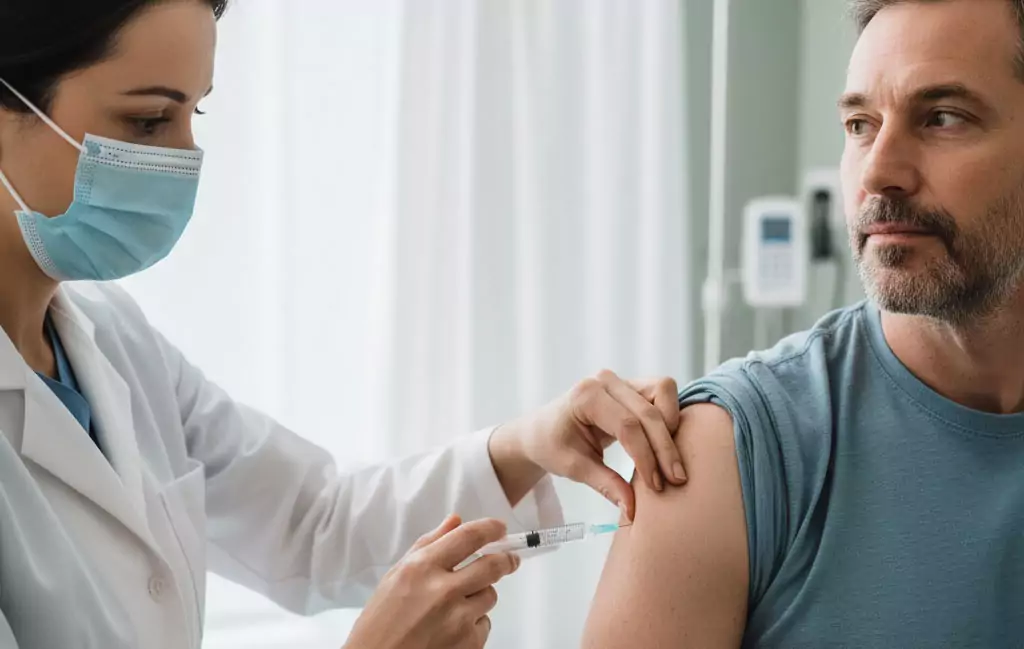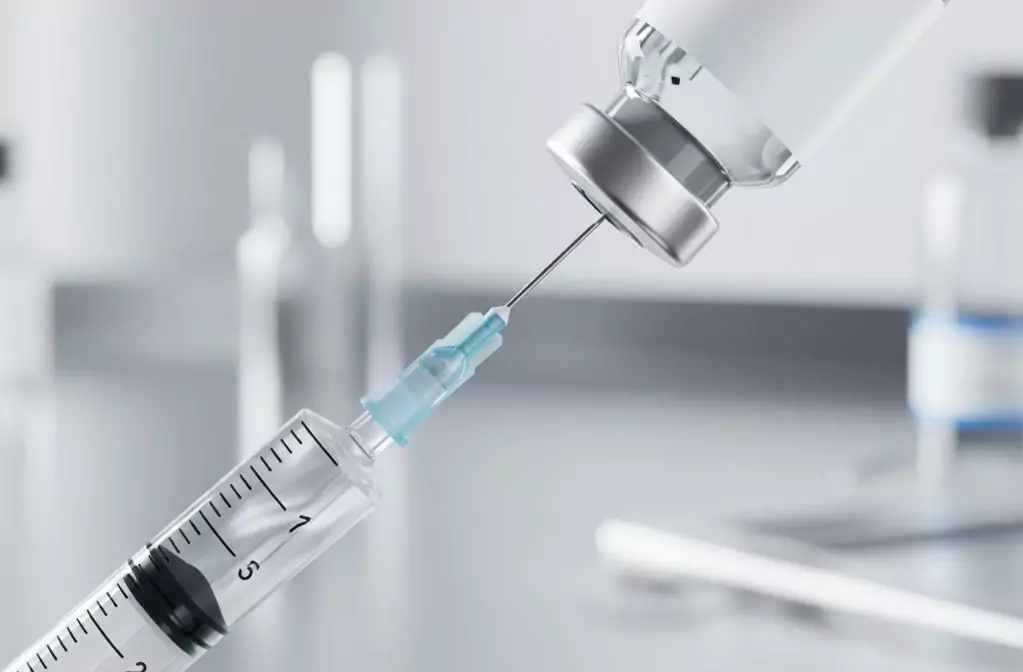Flu vaccine Lombardy
The flu vaccine is one of the cornerstones of public health prevention in Lombardy, one of the most densely populated regions in Italy. Every autumn, the flu vaccination campaign is organized by the Lombardy Region and local health authorities (ATS) with the goal of protecting the population from seasonal influenza and its complications — especially in large cities like Milan, where respiratory viruses spread more easily.
Getting vaccinated not only protects your own health but also contributes to the collective good by reducing transmission and easing the burden on emergency rooms and hospitals during the winter months.
n this article, you’ll find out when the flu vaccination campaign starts in Lombardy, who is eligible for the free vaccine, where to book it in Milan, and which types are available.
If you’d like to receive personalized information or book your vaccination right away, contact us for support and up-to-date guidance.

Why get the flu vaccine
Flu is a highly contagious viral illness that affects millions of Italians every year. Although it usually resolves without complications, it can cause pneumonia, worsen chronic diseases, and lead to serious outcomes in vulnerable individuals.
The flu vaccine significantly reduces the risk of infection and, most importantly, lowers the likelihood of severe illness.
In Lombardy — where daily mobility and social interactions are high — vaccination is an essential tool of public health protection.
When the vaccination campaign begins in Lombardy
Every year, the Lombardy Region publishes the official schedule for the flu vaccination campaign, which generally begins in October.
The first few weeks are dedicated to high-risk groups, while in November and December the vaccination is extended to the rest of the population.
The composition of the vaccine changes annually, following the recommendations of the World Health Organization (WHO), which updates the viral strains based on the most likely variants to circulate during the upcoming flu season.
Who is entitled to the free flu vaccine
The vaccination is free of charge for several categories considered to be at risk:
| Category | Reason or condition |
|---|---|
| Over 65 years | Higher risk of complications |
| Children 6 months–6 years | Early prevention and reduced household spread |
| Pregnant women | Protection for mother and newborn |
| Patients with chronic conditions | Heart disease, diabetes, COPD, immunodeficiency |
| Healthcare and social care workers | Protecting patients and facilities |
| Residents of nursing homes and community facilities | Higher exposure to infection |
All other citizens can still receive the vaccine at an affordable cost, at participating pharmacies and authorized vaccination centers.
Where to get vaccinated in Lombardy

The flu vaccine can be administered at several locations throughout the region, with particular focus on major urban areas such as Milan, Monza, Bergamo, and Brescia:
- General practitioners and family pediatricians, who remain the primary point of reference for most families.
- ATS vaccination centers, distributed across the regional territory.
- Participating pharmacies, which increasingly offer on-site vaccination services.
How to book the flu vaccine
ou can book the flu vaccine through several methods:
- Online portal of the Lombardy Region – accessible with SPID, electronic ID card (CIE), or health card.
- Regional toll-free number – available for those who do not use digital tools.
- Pharmacies and ASST health facilities – often manage bookings directly on site.
Note: To receive the flu vaccine, you must be registered with the Italian National Health Service (SSN) or present a valid ID and tax code (codice fiscale).
If you are temporarily living in Lombardy — for work, study, or other reasons — you can still get vaccinated by presenting your medical chart.
Contact Infinitydoc to obtain your chart and get vaccinated today!
In Milan, many residents choose to get vaccinated at local pharmacies or private medical centers affiliated with the regional program, which offer quick appointments and flexible hours.
The booking system is centralized through the official Lombardy Region portal, allowing users to select the vaccination site and appointment time.
Flu Vaccine Booking – Lombardy Region >>
Flu vaccines: types and how they work
Every year, the World Health Organization (WHO) analyzes circulating influenza strains across the two hemispheres and issues recommendations to update the composition of the flu vaccine.
This annual review is essential because the influenza virus mutates rapidly: even small genetic changes (known as antigenic drift) can make the previous year’s protection less effective.
For this reason, the Lombardy flu vaccine is reformulated each autumn based on the strains most likely to circulate during the winter season, ensuring targeted and up-to-date coverage.
How the flu vaccine works
The vaccine “trains” the immune system to recognize and fight influenza viruses.
After administration, the body produces specific antibodies that remain active for several months. When exposed to the actual virus, the immune system is already prepared to defend itself, significantly reducing the risk of infection or serious complications.
Unlike many childhood vaccines that provide multi-year protection, the flu vaccine must be repeated every year, as influenza strains change continuously.
Main types of flu vaccines available in Lombardy

In Lombardy, several formulations of the flu vaccine are available, each designed to meet the needs of specific age groups or health conditions.
All vaccines used are approved by AIFA (Italian Medicines Agency), the ISS (Italian National Institute of Health), and the EMA (European Medicines Agency), and they comply with strict safety and quality standards.
1. Inactivated quadrivalent vaccine (QIV)
his is the most common and widely used type of flu vaccine.
- Composition: contains four influenza virus strains (two type A and two type B) that are inactivated, meaning they cannot cause illness.
- How it works: stimulates the immune system to produce specific antibodies without exposing the body to a live virus.
- Indications: recommended for adults, adolescents, and children over 6 months of age.
- Advantages: provides broad coverage and an excellent safety profile, with minimal side effects.
2. Adjuvanted vaccine
This is an enhanced vaccine designed to improve the immune response in the most vulnerable individuals.
- Composition: contains an adjuvant, a substance that amplifies the immune system’s response.
- How it works: provides a stronger and longer-lasting protection, even when the body’s natural immune response is weakened.
- Indications: recommended for older adults (over 65 years), frail individuals, and patients with chronic diseases such as heart conditions, diabetes, COPD, or immunodeficiency.
- Advantages: significantly boosts antibody production and reduces the risk of severe influenza and pneumonia.
3. High-Dose vaccine
Specifically designed to compensate for the natural decline in immune response that occurs with age.
- Composition: contains a higher amount of antigen compared to standard vaccines.
- How it works: stimulates a stronger antibody response in individuals with a less reactive immune system.
- Indications: intended for people over 75 and those affected by immunosenescence (age-related weakening of the immune system).
- Advantages: increases overall protection and reduces the risk of hospitalization due to flu-related complications.
4. Nasal spray vaccine (Live Attenuated)
An alternative option designed for children and young people, eliminating the need for an injection.
- Composition: contains live but weakened (attenuated) viruses that cannot cause illness.
- Administration: delivered as a nasal spray, quick and painless.
- Indications: recommended for children and adolescents aged 2 to 18 who are in good health and do not have immunodeficiencies.
- Advantages: stimulates a natural immune response similar to that triggered by an actual infection and is especially suitable for children who are afraid of needles.
In summary, the choice of flu vaccine in Lombardy is made by the family doctor or pediatrician, based on:
- the patient’s age;
- overall health condition;
- presence of chronic illnesses or immune disorders;
- possible allergies or contraindications.
Regardless of the type selected, the flu vaccine remains the most effective and safest form of prevention to face the winter season with greater protection — particularly in densely populated areas such as Milan and the Lombardy metropolitan area.
Duration of protection
After vaccination, the immune system takes about two weeks to develop effective protection.
This immunity remains active for 6 to 8 months, which is sufficient to cover the entire period of viral circulation — typically between December and April.
For this reason, it is recommended to get vaccinated between October and November, ensuring immunity is fully developed before the seasonal flu peak.
Effectiveness and benefits
The effectiveness of the vaccine depends on several factors, including age, overall health, and how closely the viral strains included in the vaccine match those actually circulating.
On average, vaccination reduces the risk of symptomatic illness by 40% to 70%, and for those who still contract the flu after being vaccinated, symptoms are typically much milder and complications are rare.
Multiple clinical studies confirm that vaccination:
- Reduces hospitalizations by up to 40% among people over 65.
- Prevents cardiac and respiratory complications in patients with chronic conditions.
- Protects newborns when the mother is vaccinated during pregnancy.
- Limits the spread of the virus in communities, schools, and workplaces.
Safety and possible side effects
The flu vaccine is safe and carefully monitored. When side effects occur, they are generally mild and temporary:
- Pain or redness at the injection site
- Mild fever or general discomfort
- Temporary fatigue
Serious reactions are extremely rare and are constantly monitored through regional and national pharmacovigilance systems.
Sources for further information:
- Lombardy Region – Vaccinations – information on vaccination campaigns
- Italian Ministry of Health – guidelines on prevention and vaccines
Benefits for the community
The flu vaccine is not just a form of individual protection — it is a true public health tool.
Getting vaccinated means contributing to the safety of the entire community: when a large portion of the population is immunized, the circulation of the influenza virus decreases dramatically, protecting even those who cannot be vaccinated for medical or age-related reasons.
1. Community (or Herd) immunity
This positive effect is known as community (or herd) immunity.
When the virus encounters more people who are already immune, it has fewer opportunities to spread. This breaks the chains of transmission and limits outbreaks, even in crowded places — such as schools, public transport, nursing homes, and offices — which are especially common in densely populated cities like Milan, Brescia, and Monza.
Thanks to this indirect protection:
- Newborns and infants under 6 months, who cannot yet be vaccinated, are less exposed.
- Elderly and immunocompromised individuals are better protected, even if their immune response to the vaccine is partial.
- The likelihood of seasonal epidemics that could overwhelm hospitals is significantly reduced.
2. Reducing the burden on healthcare services
Every winter, influenza is one of the leading causes of emergency room visits and hospital admissions in Lombardy.
Greater vaccination coverage translates into:
- Fewer medical visits and unnecessary antibiotic prescriptions
- Fewer hospitalizations for respiratory complications, pneumonia, and worsening of chronic diseases
- Lower costs for the regional healthcare system, freeing up resources for other treatments and emergencies
According to data from the Italian National Institute of Health (ISS), achieving vaccination coverage above 75% among people over 65 can reduce hospital admissions for flu and related complications by up to 40%.
3. Benefits for schools, workplaces, and communities
Vaccination also helps maintain social and economic continuity:
- It reduces school and workplace absences caused by the flu.
- It limits virus transmission within families, offices, hospitals, and residential facilities.
- It indirectly protects caregivers and essential workers, such as parents, teachers, healthcare professionals, and home assistants.
In a city like Milan, where social contact is frequent and intense, getting vaccinated takes on an even more tangible value: it helps keep essential services running and protects public health during the most critical winter months.
4. An ethical choice and a social responsibility
Choosing to get vaccinated against the flu is also an act of solidarity.
Every vaccinated person reduces the likelihood of transmitting the virus to those who cannot protect themselves — such as newborns, cancer patients, or individuals with severe allergies to vaccine components.
This simple gesture helps build a more aware, protected, and resilient society.
5. A concrete contribution to collective prevention
In Lombardy, the Regional Government and local Health Authorities (ATS) promote awareness campaigns to highlight the importance of vaccination.
The goal is not only to prevent influenza but also to reduce complications, ease the strain on the healthcare system, and ultimately save lives.
Each administered vaccine represents a small but meaningful step toward a healthier and more protected community.
In summary
Getting vaccinated is not only a personal choice but also a civic duty that strengthens everyone’s health.
In a dynamic region like Lombardy, where millions of people interact daily, the flu vaccine is a practical and essential measure to:
- Protect the most vulnerable,
- Prevent seasonal epidemics,
- Contribute to the stability of the healthcare system.
Each vaccinated person becomes, in effect, a barrier against the virus, helping to build a safer winter for themselves and for the entire community.
Getting vaccinated in Milan: a practical example
In Milan, the vaccination campaign is supported by numerous municipal pharmacies, medical clinics, and doctor’s offices.
In recent years, the City of Milan has also promoted vaccination in temporary public spaces—such as community centers and gyms—to encourage the highest possible participation.
The result has been a significant increase in vaccination coverage, particularly among people over 65 and healthcare workers.
Conclusions
The Flu Vaccine Lombardy remains the most effective way to protect against influenza and its complications, especially in metropolitan areas like Milan, where viral circulation is intense.
Taking part in the vaccination campaign means protecting yourself, your family, and the entire community.
Frequently Asked Questions (FAQ) about the Flu Vaccine in Lombardy
It generally begins in October, to ensure protection before the epidemic peak between December and January.
No. You don’t have to be a resident of Lombardy to receive the flu vaccine in the region. However, you must be registered with the Italian National Health Service (SSN) or provide a valid identification document and tax code (codice fiscale). If you’re temporarily living in Lombardy: for work, study, or other reasons: you can still get vaccinated at with a doctors chart!! Contact Infinitydoc to get your chart and get vaccinated today!!
At general practitioners’ offices, ATS vaccination centers, participating pharmacies, or other authorized healthcare facilities.
t’s free for people over 65, young children, pregnant women, chronic disease patients, and healthcare workers. Others can receive it for a small fee.
Mild fever, arm soreness, or temporary fatigue — all mild symptoms that disappear within 1–2 days.
Yes, according to the Italian Ministry of Health’s recommendations, as long as your doctor identifies no contraindications.
Protection lasts about 6–8 months, so it’s advisable to repeat vaccination each year.
Yes, it’s recommended for children aged 6 months to 6 years, with different dosages depending on age.
You can call the regional toll-free number or book directly at your local pharmacy.
Yes, it’s possible for several reasons:
1. Strain variability: The vaccine targets the 3–4 strains most likely to circulate, but other flu strains not included can still cause illness.
2. Partial effectiveness: Effectiveness varies from year to year and person to person. Even if it doesn’t prevent infection completely, it significantly reduces symptom severity, hospitalizations, and complications.
3. Flu-like viruses: The vaccine protects only against influenza viruses. Other viruses (e.g., rhinoviruses) can cause similar symptoms.
In summary: vaccination remains the best protection against severe forms, though it doesn’t guarantee complete immunity.
Mild effects such as fever, muscle pain, or headache usually appear within 6–12 hours after vaccination and resolve within 1–2 days.
Pain or redness at the injection site may last slightly longer but typically disappears in a few days.
These are normal signs of the immune system’s response.
The flu vaccine does not cause the common cold. Main reasons include:
1. Different viruses: The vaccine protects against influenza viruses, not those causing the common cold (e.g., rhinoviruses or non-COVID coronaviruses).
2. Timing: Vaccination occurs at the start of cold season, when cold viruses are already circulating. It’s often a coincidence.
3. Mild immune reactions: Occasionally, mild immune activation (runny nose, congestion) can resemble a cold but lasts only 1–2 days.
The flu vaccine is generally safe, but it’s contraindicated or should be postponed in certain cases:
Absolute contraindications:
– Infants under 6 months (not approved for this age group).
– Severe allergic reaction (anaphylaxis) to a previous flu vaccine dose or one of its components (e.g., egg proteins in specific formulations).
– Guillain-Barré Syndrome (GBS) occurring within six weeks of a previous flu vaccination.
Temporary contraindications (vaccination should be delayed):
– Moderate or severe acute illness, such as infection or high fever — vaccination should wait until recovery.
To be carefully evaluated with a doctor (for certain vaccine types):
– Patients with severe immune suppression, especially when live-attenuated vaccines are considered (not used in injectable form in Italy).
Note: a common cold or mild illness without fever is not a contraindication for vaccination.










